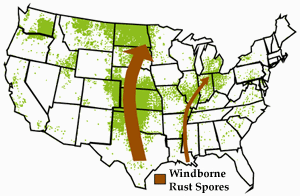Some of the earliest planted wheat in Tennessee has begun to head and with warming temperatures wheat will most likely develop at a quick pace and dependent upon weather conditions diseases could do the same. The most prevalent diseases across the Mid-South seems to be the leaf blotches, but at low severities. To date there have been very few disease reports in Tennessee with only some leaf blotches (Septoria and/or Stagnospora blotch) and possibly tan spot in the lower canopy reported. These diseases, restricted to the lower canopy will cause very little, if any damage to yield, but as the temperature increases, moisture will play an important role in how much or how little they develop into the upper canopy. Scouting often, every 3 to 4 days, will help monitor if a fungicide application is necessary to keep the flag leaf disease free. More information on wheat diseases and management can be found at UTcrops.com/wheat/insects_diseases.htm, specifically the Wheat Disease Identification booklet has symptom descriptions and images developed by the multi-state extension and research committees for small grain diseases and others; and common fungal wheat diseases found in the Mid-South publication has more information on weather conditions that promote disease development.
No wheat rusts have been reported in Tennessee as of yet. This can be expected with the cold winter and very few incidences of wheat rusts being reported from the Southeast, which is where rusts are blown in from (see figure below – Wheat Rust Pathways). As of April 16, Louisiana reported very little leaf rust and only traces of strip rust, Mississippii – very low to trace amounts of leaf and stripe rust, and Arkansas has reported 1 hot spot of stripe rust in Marianna, AR (near Memphis, TN). More information on wheat rust situation reports and bulletins can be found at http://www.ars.usda.gov/Main/docs.htm?docid=9757.

As wheat gets closer to flowering check the Fusarium Head Blight Prediction Center (www.wheatscab.psu.edu) for risk levels for your area. So far Tennessee is at low risk for head scab (Fusarium head blight), although warmer temperatures and rain during flowering can change that so also be aware of your own local weather forecast to better guide fungicide decisions at flowering. Remember only fungicide products that are solo triazoles should be applied for prevention/management of head scab. More information on different fungicides and their efficacy on wheat diseases can be found on the table below (click to enlarge) and at UTcrops.com.


